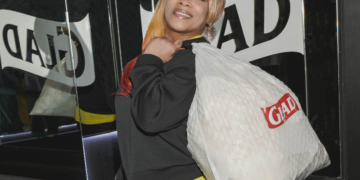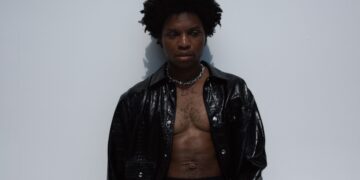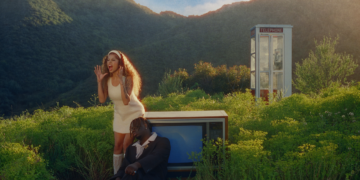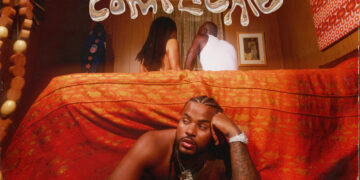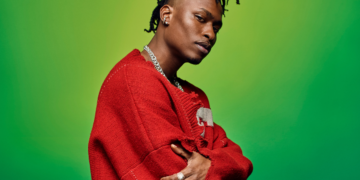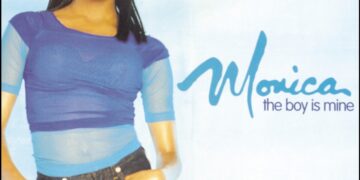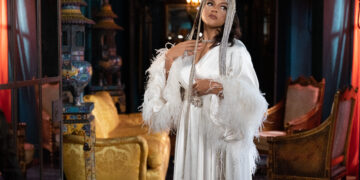Sophie Muller lives in a world of her own. The renowned British music video director prefers it that way, she tells Rated R&B on an afternoon in May, from her home across the pond.
“It’s a conscious thing. I’ve consciously, my whole career, tried to not be pigeonholed. I’ve had a country career. I’ve had an R&B career. I go everywhere, but I’ve done it by staying under the radar,” Muller says.
As a naturally private person, Muller rarely does interviews such as this. She rather let her extraordinary stunning visuals do all the talking. Her 30-plus year showreel, with moving images often strikingly artsy and focused on modern beauty, includes many for artists like Beyoncé, Sade, Annie Lennox, Gwen Stefani and Selena Gomez.
Though Muller has received a Grammy award and other accolades for her directorial work, she never intended to make music videos. In fact, she always envisioned herself pursuing a career as an art filmmaker and dismissed the idea of shooting music videos.
“I thought I was going to be a great artist. I always thought I was pretentious,” she admits to Rated R&B. “I remember someone at the time going, ‘You should make music videos.’ I was like, ‘Ugh, over my dead body. Are you joking?’ I didn’t like the idea of that being my job.”
Her studies at St. Martin School of Art and Royal College of Art didn’t necessarily steer her in the creative direction she desired, either. “The films I made there were not really narratives,” she recalls. “They were like all music space and arty. There were no actors or anything. It was just images over music.”
After completing graduate school, she found it incredibly hard to get work in her dream profession. Muller eventually gave in to directing music videos. She wasn’t an overnight success, though.
“I was a total failure for ages. I could never get a job and no one would look at my reel,” she remembers.
Her first big break came slowly, but surely. In 1987, she directed the video for Eurythmics’ – comprised of Annie Lennox and Dave Stewart – song “I Need a Man.” Stunning glamour shots capture Lennox beset in Marylin Monroe-esque aesthetics, putting on a one-woman show in dim lighting.
Muller says after working on this radical video for the former pop duo, she was never out of work again. Remaining sought-after in an industry like videography isn’t easy. The key to Muller’s longevity is quite simple: She doesn’t limit herself to one genre style. From the outside, it may appear that most of her artful and elaborate visions were primed for pop stars. As a chameleon of visual sorts, she considers her style one “quite hard to pin down.”
Her genuine ability to build with each artist she works with also makes her style of directing quite unique. “I always try and do right by the artist, like I try and do what’s best for them,” she says.
“I try to give them a comfortable arena to be as great as they can be. I always listen to them, and I always want them to like it. I always hope that I provide some kind of platform, where they can be truthful about themselves.”
That said, her concern and appreciation for those artists in her visual care have drawn each of them to work with more than once. One artist, in particular, is soul force Sade Adu, who Muller attended school with at St. Martin College of Art.
“We would sit in the library together, being naughty. She was doing fashion and I was doing graphics. Neither of us liked our courses, so we would sit in the library and we became friends,” Muller remembers.
The two didn’t see each other for a while after going their separate ways after graduation. It wasn’t until Muller received an invitation to see Sade perform at Ronnie Scott’s, a famous jazz club in West End London, that she learned what her college friend had been up to in the interim.
“I would never ever have known she wanted to be a singer or a songwriter,” Muller says.
As Sade went on to become the lead vocalist of an internationally-known band, Muller was in and out of work. It wasn’t long before the two reconnected again, and the rest is history.
The first video she directed for the group was “Love is Stronger Than Pride,” the lead single and title track of their third studio album. Since that time, Muller has directed more than a dozen videos for Sade, as well as filmed live tours and photographed album booklets.
In Rated R&B’s exclusive interview with Muller, the celebrated director goes even further behind the lens of memorable music videos she created for R&B artists. She also discusses her relationship with Sade and hints if she’s involved with their next album.
The infamous video for Maxwell’s “Luxury: Cococure” is hard to locate these days. It features him in one of the most calming settings: a bathtub. Where did the concept for this sensual video come from? Is there a reason the full video can’t be found online?
Are you serious? I actually am really surprised to hear that it’s not on YouTube. It used to be. I’ve had a lot of people in bathtubs in videos. With this one, he was in Paris and said, “Can I come make a video?” I made a video for him before. I knew him and we were friendly. There was no crew. It was all made on Super 8 [film camera]. It was one of those things where, “Okay, what could he do in a hotel room?” Sometimes when you make videos you don’t always have a storyboard. You have to make it up as you go along.
I think what was great about Maxwell is he is bound breaker that you can’t really pigeonhole him as a type of artist. With the video, It was just more about showing him being vulnerable. I don’t think it was trying to be sort of sexual. It was more like, “Okay, we’re in a hotel. We could sit in a chair or do you want to go in the bathtub?”. There was nothing underlying like, “Oh, let’s do this to be different and shocking.” It was literally like, “Okay, we got two hours. What are we gonna do? I’ve got a camera.”
Maxwell seemed to be overjoyed and in touch with himself in the short video snippet available online. What do you remember about the tone on set for this video?
He’s a lovely person like that. He wasn’t posturing. You know how a lot of videos are about saying “I’m this, I’m rich, I’m pretending to be richer than I am. I’m trying to be more handsome than I am.” It was more just about being a person and I suppose not having stuff and not trying to tell people, “I’ve got stuff.”
Maxwell’s video for “Whenever Wherever Whatever” falls in line between slightly disturbed in terms of creepy and miserable as it relates to missing someone. What was the creative inspiration between this video?
I love making videos in hotel rooms. I like making videos in small spaces where you’re dealing with the minutiae of something rather than largeness of something. I was always kicking against the idea that you have to always make videos that have hundreds of sets and people. I was always trying to find the simplicity of a drama in one room. The idea for that video was to use almost no light because that was shot on film, which was before digital. I know that we were trying to make a video without lighting it much, if that makes sense. It was very low light and at that point, that was quite, I guess, a daring thing to do. Then the idea with this moves around the room. He almost sees himself in other parts of the room doing other things, so there’s a slight schizophrenic quality to it. Still, you’ve got this sense of intimacy and simplicity about being in one location.
“Ring The Alarm” is one of those Beyoncé videos that doesn’t get enough credit. During the movie-inspired video, you did a fantastic job at capturing the range of emotions in the song’s lyrics to the point where you almost felt sympathy for the crime she committed. From a woman’s perspective, how important was it for you to emphasize her differing roles as both a presumably accused person and an emotionally abused victim?
I agree. I love that video. It’s a sort of philosophy idea that no one chooses to be a mass murderer. I mean, you don’t grow up and go, “When I grow up, I’m going to be a murderer. I’m going to be a psychopath.” I think there’s different sorts of crime. Obviously, there’s crimes that involve getting loads of money and that’s bad, but a lot of emotional times, sometimes people are criminals because they’ve had crimes committed on them. It’s common knowledge that people who were abused as children tend to sometimes grow up and be abusers. It’s a cycle. It’s more like that thing of looking at the depth of a character and why this happened.
The idea of the video was that she’d kill someone and that was pretty subtle. It was very understated that something bad has happened. You’d see a body under a sheet and flashing lights and stuff but you didn’t really see anything. She’s also quite empowered in the video. I think it’s interesting how when you have emotions that are flipping from one to the other, so we wanted to show that in the video. That video was just someone fluctuating from extreme emotions. I remember my very first idea I had for that video was how it opens with her doing that dance in the red light on a desk. No idea where I got that idea but I remember that I had this idea and that was it. Everything else grew from that.
Was it intentional not to get the details on the serious nature of her crime and focus just on the pain and rage she felt as a scorned lover?
Yeah. It’s like someone who’s hurt has done something, we don’t really know what it is. She may have killed him. It may have been a metaphor. We don’t know but she’s obviously really mad. She’s angry and really hurt, so those are all emotions that lead to crimes of passion. I think we were trying to do something that was classier than showing what she’d done. It was more like people could guess.
How involved was she in that creative process of this music video and others?
She was always very involved. She always wanted to be a part of everything. The first video I made with her was “Deja Vu,” then I made [“Ring the Alarm”] and a couple more after that. I went to New York to meet her before we did “Deja Vu.” She’s that kind of person. She doesn’t just turn up to the set. We had loads of meetings. It was really tricky to come up with an idea for [“Deja Vu”] because it was a feeling vibe song. It wasn’t a story.
The video for [“Ring the Alarm”], I felt like you could have a story —just the energy and attitude to it. With the first video, I just never worked with anyone who wanted to shoot all day. Even then, she’s like, “Let’s do one more set up. I have one more outfit let’s do it,” and I was like, “We’ve already done 10.” It’s like, “Let’s do one more, let’s do one more.” She’s incredibly hard-working. She always wanted to improve and make it better, even more than me. So, I knew what I was dealing with when I did [“Ring the Alarm”]. I knew that she would go for it.
What was the symbolism of the sweat on Beyoncé’s back in the opening scene of the “Deja Vu” video?
I think it was just meant to be that allusion to the New Orleans heat. She’s quite sweaty in all of it, actually. In the bit where she came in wherever that bar was to JAY Z, she was really sweaty there. We shot it in New Orleans. It was boiling hot, so we kind of went with the steaminess of that kind of feeling of tropical heat. Again, it’s extreme devotion on Beyoncé’s part. A lot of the imagery was based on the photographer [E.J.] Bellocq. He took pictures of prostitutes in New Orleans in the 1890s or something like that. The story of him was his photographs were lost. The pictures themselves were very famous. While they were prostitutes, they’re classy because some of them have piles of clothes on them. Beyoncé is dressed up in a lot of it like the Victorian petticoats and undergarments. So, the palette was kind of like fashionable passion photography. So, I think she carried off the sweatiness. She looks amazing like that.
You helped kick off the visual rebirth for Beyoncé during the B’Day album with “Deja Vu,” while including references from her creole heritage. How significant was it for her to draw attention to her creole roots in the video? And talk more about the vision of the video.
Of course, I think that was very important to her. She was the one who wanted to film in New Orleans. I’m from London, so it’s a long way from my points of reference. My points of reference are artistic, like as I said, like Bellocq, the photography, that’s what I know about New Orleans. I have been there but I didn’t really know a lot and they were like, “I wanna film this in New Orleans.” I kind of had ideas of what I wanted it to be like, but not having been there a lot, it was hard to come up with ideas. I went along with her idea and I loved doing it. I didn’t want it to be cliché because sometimes when you don’t know a place, you know of it, you could somehow sometimes fall into cliched imagery. Like, if someone comes to London and films a red bus, I think it’s embarrassing. So I was trying not to do that. Her dancing that bit in the sand is one of the most amazing things she’s ever done — not with me, just her, how amazing she is in that bit.
They very much wanted different hair, different looks, all the way through. I tend not to do that with my videos because I like people to just be one person in their videos. Normally, in my videos, they’ll only wear one outfit, unless they want two. Some people love just dressing up. So if it had been me, I probably would have had the same outfit all the way through, in different locations, because then that, to me, would have made sense. It would be like, she’s moving, she’s running, she’s trying to get to JAY [Z] or whatever. But I just went with their ideas and it became beautiful and exciting because there were so many different looks and fashions in it.
From running through a tall grass field to wildly dancing and kicking up sand, Beyoncé served multiple fashions and toured different locations in New Orleans throughout the video for “Deja Vu.” What was your most exciting scene to shoot, as well as your most difficult?
It was pretty difficult. It was hot and we did a lot of moving around. I hadn’t worked with her before. I remember when we filmed the African bit, I call it, when she does the dance in the sand, I remember at that point thinking, “Wow. She is unbelievable.” We really lucked out. The sky was gorgeous. That was a really happy bit. The bit when we were on the water and she’s wearing a purple dress, that was horrific because we basically were going along a river and hit a wasp nest that was on one of the low hanging trees. We all had to dive down and lie on the blankets. We were dive-bombed by very angry wasps. It was really scary.
Overall, it was just hard work. It was just after [Hurricane] Katrina, so it was really, really in a bad way. The crew had nothing. All the film equipment was all water damaged. I remember working with the art director who lost everything in the flood. In the hotel, there was no room service because there was no one to work. It was just a weird time, a bit like now. But, it was a pleasure. [Beyoncé’s] amazing. It’s like an honor to work with somebody who’s that amazing. She gives everything.
Motherhood was an important theme for Alicia Keys’ Girl on Fire album because it was her first project since giving birth. While she could have chosen to be a fictional superhero in the video for the title track, she chose to play a mom. What was the vision behind this video?
I really struggled to try to come up with an idea for that video. The most obvious thing to do was kind of the big medalist and world-class people doing this and people doing incredible things. What if it’s just about normality? What if it’s just about someone doing what we all do? That’s the girl on fire — not the higher achiever. It’s the every day. I remember having that thought and [Alicia Keys] really liked that idea. It was about someone being there with their mom, being a mom, looking after people and doing cleaning and washing and everyday things that millions of women do. That’s the girl on fire. We shot the video in London. It wasn’t meant to be so retro. It was something that was beautiful. I didn’t want to show her in a kind of beige apartment, hoovering. It became this thing of, “What’s the most colorful, glorious thing we can do with someone being at home?” So, those colors were based on Hollywood films and Wong Kar-wai’s In the Mood for Love …just beautiful cinematography using color.
Since the band Sade’s Stronger Than Pride album, you’ve directed all dozen of videos for the group, particularly the visuals for their first singles. Out of the videos for “Love Is Stronger Than Pride,” “No Ordinary Love,” “By Your Side” and “Soldier of Love,” which album lead single were you most proud to be a part of?
“No Ordinary Love” was a really interesting video because in my experience, in those times, R&B artists tended to never play characters in videos. She played the mermaid and then someone who was in their wedding dress. It was a stretch. It just seemed like unusual imagery for an R&B video [then]. I was proud of it and I know she was. It could’ve been her in a fancy house fighting with a boyfriend or something, or her making out with a boyfriend. But it had to be an extreme story.
I think “By Your Side” is an amazing song. Personally, I don’t think it’s the best video. I projected onto her a fear of making videos. Some people love making videos. Like Gwen Stefani, for example, loves making videos. She loves being in front of the camera, having makeup and everything. Sade doesn’t. It’s not her thing. She loves writing music and singing it. She doesn’t like being filmed, particularly. So I think I overcompensated by putting her at a distance in that video. After we made it, I had been too protective of her. I was worried that she would be uncomfortable, so I tried to put her in a comfortable situation but it didn’t work out like that because to have someone just walking around through a sort of fantasy world isn’t that comfort inducing.
The video I liked the most is “King of Sorrow.” When we made [the video], I thought, “Oh my God, this is so wrong, she’s amazing, you just have to give her character. Let her be a character.” That’s what she’s great at, when she doesn’t feel like she’s being herself and she’s being a character. I learned something from that and I think that if you watch the “King of Sorrow” video, she’s amazing in that.
How was it being a part of the video for their 2010 comeback single “Soldier of Love”?
I love that song. I was in the studio a lot of the time [when] they were making the album. I did all the photographs and everything. I don’t know how [the song] was meant to sound or how she wanted it to sound, but it had this weird quality of a hard beat that was army-like. Also, it was plaintive and yearning for something, but also standing your ground and like, “I’m gonna save you because I’ve lived this war, and I’m gonna save you because I am a soldier of love and I’ve done it before.”
For the video, we always imagined it would be in a desert. It’s the same thing with Alicia’s “Girl on Fire.” It’s like, “Yes, she’s a housewife, but let’s make it look amazing.” It’s the same prospect. She’s not in a desert, and it’s real scary and dry. She’s in a desert, but it’s metaphorically speaking. I know she’d like the bit when she’s on the horse. I know she’s an amazing rider. The idea was to let her be in charge of the guys, let her be the commander. She’s strong, she’s not gonna be really girly in it. She wanted to be stronger — not vulnerable. She’s not a victim.
Hopefully, you’re a part of their next album and era whenever that happens, especially with everything that’s going on around the world. Everyone is anticipating their return.
Well, I think it would have been this year. Of course, there’s been a lot of series of events occurring where things have slowed the world up. Maybe next year. She’s working. The thing with her is every time, she leaves 10 years. Who does that? Nobody does that, right? No one else does it. She doesn’t go away and come back, that’s just her rhythm. She’s not afraid. I think you’ll find most artists are full of fear and they’re like, “Oh my God, if I don’t drop something in the next year, they’re gonna forget about me.” Sade doesn’t care. She knows people love her and she knows they’ll wait. She believes in doing something when she’s ready.
Besides Sade, live albums are missed in music today. Sade released two live albums including Lovers Live in 2002 and Bring Me Home: Live 2011. Both albums had video components in which you directed. What was your experience like being a part of those live albums?
It’s like very hard work and stressful shooting concerts. When people always say, “Will you film my concert?,” I always say, “I have to tell you that before you’ve even started doing a live concert, you’ve failed.” There’s no way in my mind you could ever recreate a live concert. I just don’t think it’s possible. I’ve made a few live things and I don’t enjoy it because I feel you fail before you start. I don’t mean it’s a bad thing. I just mean it’s a long show and it’s hard to make it good and it’s not as great as being there. Being in a live concert is such an amazing experience, when it’s a good one, because you feel you’re a part of something.
Putting a concert together is really fun. It’s really creative. It’s amazing and it’s probably one of my favorite things. The last one we did, Bring Me Home is by far the greatest thing I’ve ever been part of. So fantastic, the whole experience. I thought, “We did all that together.” I think it was successful and I don’t mean on a monetary level. I mean it succeeded in enthralling people when they were there. I think to me, that was a very creative endeavor that we all did that show. It was a special show. I mean Lovers Live, I know it was good. I don’t have the same feeling about it. I can’t even remember it. I’m sure if I watched it, things would come back, but I haven’t watched it for a long time, so I don’t remember much about it.


